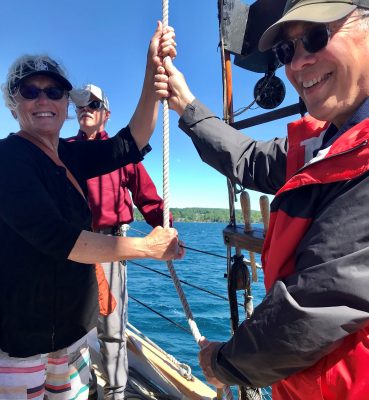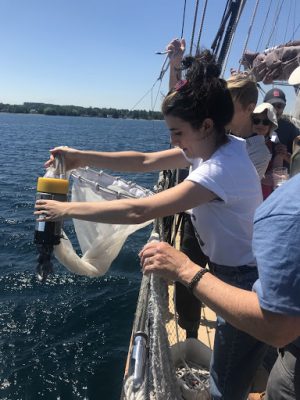While Inland Seas Education Association is not a research institution, but an educational institution as the name suggests, every one of our programs involves some level of data collection. And, guess what! If you have ever sailed with us, you have contributed to a collection of thirty years of ecological data.
Across our programming there are a number of opportunities to collect samples and data. Specimens that are studied at stations are obtained by participants whether that’s collecting a highly concentrated sample of plankton or helping trawl for fish or microplastics. On some sails, participants use specialized tools to gather weather measurements like air temperature with a thermometer or wind speed and pressure with an anemometer. Performing wet chemistry to measure water quality is a data collection station that has been highly disrupted by Covid-19 but is an instructor favorite. All the readings and samples collected are recorded and digitized.
 If we are not a research institution, then why do we even want this data? Well, a big part of what we are teaching students and the public is how the ecosystem is changing over time, what is driving those changes, and what those changes mean for the Great Lakes. By using consistent sampling procedures, we can compile that raw data into educational visuals such as charts and graphs that illustrate trends. Our data on water clarity, collected via a tool called a Secchi Disk, allows us to create one of our most frequently used graphs onboard. This tool depicts the increase in water clarity which aids us in educating participants on the impact of Zebra and Quagga mussels, a highly relevant topic in Great Lakes ecology.
If we are not a research institution, then why do we even want this data? Well, a big part of what we are teaching students and the public is how the ecosystem is changing over time, what is driving those changes, and what those changes mean for the Great Lakes. By using consistent sampling procedures, we can compile that raw data into educational visuals such as charts and graphs that illustrate trends. Our data on water clarity, collected via a tool called a Secchi Disk, allows us to create one of our most frequently used graphs onboard. This tool depicts the increase in water clarity which aids us in educating participants on the impact of Zebra and Quagga mussels, a highly relevant topic in Great Lakes ecology.
Microplastics in the Great Lakes is a relatively recent topic in the spotlight of ecological discussion, and we are able to use our own sample collections to educate about these trends as well. Participants help trawl for microplastics, and they have the opportunity to pick through the samples and study their findings under a microscope. These samples are saved and checked by our staff over the winter to look for trends which are once again configured into a graph to use in our programs. Continual data collection allows us to provide the most up-to-date information from the bay so our participants are able to learn not only about general ecological concepts, but also the current status of our waters.
The knowledge from this data can also aid us in furthering our mission of encouraging stewardship and taking initiative. During Covid, Jillian Votava,our Education and STEM Coordinator, worked to get a Great Lakes project added to the Marine Debris Tracker App. As the National Oceanic and Atmospheric Administration (NOAA) explains, “The tracker app allows you to help make a difference by checking in when you find trash along our coastlines and waterways. This tool is a great way to get involved in local and global data collection” [1]. There is a section for microplastics so now Great Lakes stewards can continue to be involved in data collection even after disembarking from our schooner.
Water clarity and microplastics are two of many trends that we teach onboard. Overall, these visuals are a baseline for teaching. Rachel Ratliff, one of our Great Lakes Educators, recalls a group coming onboard from outside of the Great Lakes basin, “They had no knowledge of freshwater science at all, but they came up with a lot of questions based on our previous data and asked pointed questions about why we collect this data. They left being really excited about it.” It’s one thing to say that the ecosystem is changing, but it is different for people to actually see how drastically. Using data as a teaching tool sparks curiosity and further exploration.
Now, why don’t we just collect samples beforehand or take our own measurements and readings? We would identify the same trends and still gain these teaching tools, right? Yes, we would still be able to make the same charts and graphs, but we would lose the most valuable teaching tool, participatory science.
 As Jillian notes, “We are a platform to facilitate people participating in science. We take that very seriously and use that very intentionally.” She followed with an example, “I can tell you about Quagga mussels, but until you, the person taking in the info, A. meets a live Quagga mussel and B. uses a sampling tool to get that organism or test the clarity of the water, there’s only a certain level you can be impacted.”
As Jillian notes, “We are a platform to facilitate people participating in science. We take that very seriously and use that very intentionally.” She followed with an example, “I can tell you about Quagga mussels, but until you, the person taking in the info, A. meets a live Quagga mussel and B. uses a sampling tool to get that organism or test the clarity of the water, there’s only a certain level you can be impacted.”
Instead of just lecturing, “we are trying to model the scientific method” explains Jillian. “We have a question, we go out and make observations and collect evidence and samples, and then we look at those samples to put them into those graphs which we can then analyze to find out what the story is saying.” By involving students and the public in that methodology, we are allowing them to be active participants in the story. Then, participants feel more engaged and receptive to what our organization is trying to teach them.
For example, a surplus of data has been collected on water quality, and we could easily explain how water quality is measured and what that means for the lakes. By actually performing a Winkler titration, witnessing color changes, and studying the dissolved oxygen in the water, participants can see the process and discover part of the ecological story for themselves. By taking temperatures of surface and deep water samples, students get a glimpse of the effects of sunlight, the driving factor behind the biologic behavior of Great Lakes organisms. This discovery is what will lead to genuine comprehension and fuel future curiosity.
While education is one of our missions, inspiring and provoking a desire to take action is our overarching mission. As Rachel asserts, we want people to feel a sense of ownership by establishing “this is your water.” By engaging in the scientific process, people assume a role within the system of the Great Lakes, even if they do not leave the bay. Jillian confirms this idea by explaining, “Just spewing information is not an effective way to get people to care. The data collection is the fuel and motivation to get people to care about the resource.” People need to participate and need to engage if they are to become stewards.
So, what does this mean for Inland Seas going forward? Rachel shares, “I have never participated in citizen science on this grand of a scale before, and it’s something that’s important to our community. This is what makes it really important for us to streamline the data collection process.” Inland Seas has the goal of doing just that through our partnership with four University of Michigan graduate students. They are conducting a year-long research project focusing on our data collection and recordation in order to fully utilize this valuable data. We look forward to the presentation of their findings in spring of 2022 so that we can continue to incorporate data collection into our programming and have the greatest possible impact on the next generation of Great Lakes stewards.
Sources
[1] Parker, D. (2013, July 10). Marine Debris Tracker App: OR&R’s Marine Debris Program. National Oceanic and Atmospheric Administration. https://marinedebris.noaa.gov/partnerships/marine-debris-tracker.
This blog was written by Christina Javorka, 2021 Marketing and Communications Summer Intern for Inland Seas Education Association. Christina is studying marketing and fashion retail at The Ohio State University. Being from the Chicagoland area, Lake Michigan holds a special place in her heart. Her favorite thing about the Great Lakes is finding the treasures hidden within and telling others about them.